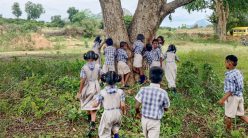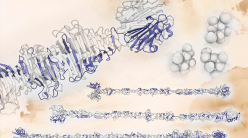Secret lives of mixed species groups
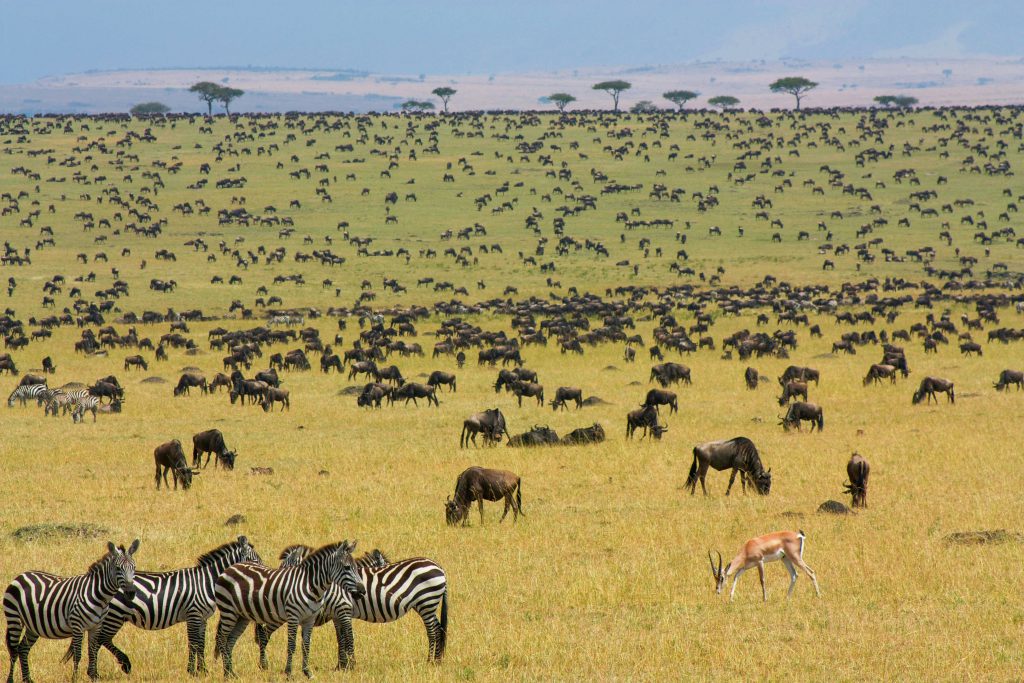
Some years ago, while driving through the scenic Masai Mara, a savannah wilderness in Kenya, Kartik Shanker made an interesting observation.
“Various species of ungulates (hoofed mammals) like gazelles, zebras, and wildebeests were foraging together, but what was interesting was that smaller individuals grouped with similarly sized individuals of other species,” recalls Kartik, now a professor at the Centre for Ecological Sciences (CES), IISc.
Many of us have grown up with images of these iconic savannahs: tall grass rippling in the wind, lions crouched low and watchful, and herds of animals grazing under the open sky. Yet these gatherings of animals are far from random. They are strategic alliances, forged in the wild, where survival often depends on the company one keeps. Such mixed-species groups (MSGs) have long fascinated ecologists, including Kartik.
One of the central questions they seek to answer is this: while it is well known that some animals often form groups within their own species, what drives individuals of entirely different species, each with its own behaviour and ecological role, to bridge these interspecies barriers and move as one?
There are complex trade-offs, shared benefits, and evolutionary pressures that make such unlikely partnerships not just possible but advantageous for survival.
These gatherings of animals are strategic alliances, forged in the wild, where survival depends on the company one keeps
Teaming up for food
Several animals, from elephants to ants, are known to live in social groups of varying sizes. “Living in groups provides a lot of shared benefits, like finding food, hunting together, or just staying protected from predators,” explains Kartik.
For example, an individual lion may not be an efficient hunter, but catching prey, especially larger ones, can be more successful when done as a team. However, single-species groups can’t expand beyond a certain limit; competition increases as all group members seek the same resources. To reduce competition while still benefiting from group living, animals form mixed-species groups, since each species will typically target different resources.
Scientists have been observing such group formations for several decades. The English naturalist Henry Walter Bates observed this in the Amazon rainforests. In his 1864 book The Naturalist on the River Amazons, the preface of which was written by Charles Darwin, he writes: “It would not be supposed that the insectivorous birds are also gregarious; but they are so; numbers of distinct species, belonging to many different families, joining together in the chase or search of food.”
Another example of such coordinated feeding comes from the forests of the Anamalais in the Western Ghats, where two langur species form a mixed-species group. Such associations – shaped by factors such as the scarcity of food resources or human activities – often influence the Nilgiri langur (Semnopithecus johnii) and the tufted grey langur (Semnopithecus priam) to come together in overlapping zones.
Both species feed on leaves, shoots, and fruits from many of the same tree species, so when these resources are patchily distributed, foraging side by side becomes advantageous. “These mixed-species groups are very efficient at foraging in dry deciduous forests … ” explains Santanu Mahato, a PhD student at the Salim Ali Centre for Ornithology and Natural History (SACON), Coimbatore.
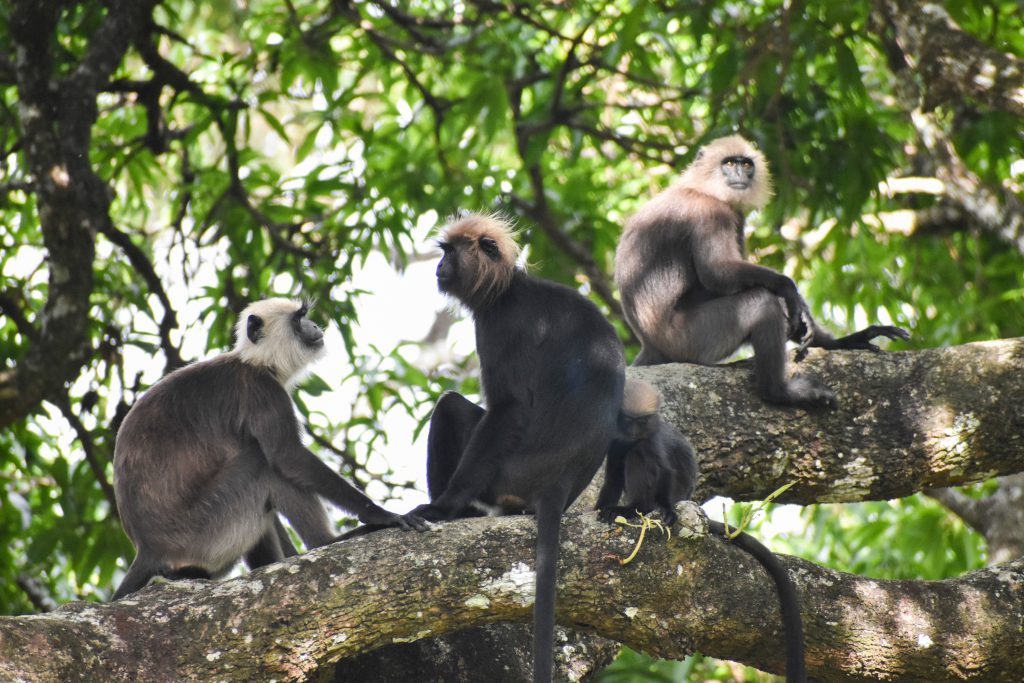
forage together in the Anamalais (Photo courtesy: Santanu Mahato)
“Unlike typical uni-male/multi-female groups, they are generally larger in group size and made up mostly of a multi-male/multi-female structure,” he adds.
Ocean ecosystems harbour such species associations, too. Coral reef fishes, like the striped parrotfish (Scarus iseri) and the ocean surgeonfish (Acanthurus tractus), are known to form groups in the Indian Ocean and forage together. Both feed on algae but, interestingly, feed in different ways which complement each other.
The parrotfish, with its strong “beak”, scrapes algae off the corals, exposing the smoother inner layers and the small organisms residing within, which then become accessible to the surgeonfish to feed on.
Outsmarting predators
It isn’t just similar food habits that prompt the formation of mixed-species groups. The striped parrotfish and ocean surgeonfish also happen to be somewhat similar in appearance. Such similarity makes it harder for predators to single out a specific target, creating confusion during an attack. The outcome is what scientists call the dilution effect: the probability of any one individual being caught decreases simply because there are more equally vulnerable targets in the group.
A study from Kartik Shanker’s lab, led by PhD student Hari Sridhar, analysed 55 datasets from 24 sites across India and found that similar-sized birds, often also similar in appearance, tend to form groups. This mirrors what is observed in fish and ungulates, where similar-sized individuals group together.
Size similarity isn’t always a rule. Sometimes, individuals of smaller species group together with larger ones to avoid aggression or predation. For example, smaller parrotbills (Paradoxornis aemodius) have been observed associating with the much larger greater necklaced laughingthrush (Pterorhinus pectoralis). Such associations may offer protection through intimidation, although research is still underway to confirm this explicitly.
Another way mixed-species groups reduce predation risk is by increasing vigilance – more eyes to spot danger. For example, in the Masai Mara grasslands, the space is so open that grazing ungulates are vulnerable to predator attacks, making group formation an intelligent strategy. These are supplementary benefits, as ecologists like to call them, where each member contributes to the safety and welfare of the group, allowing individuals to feel safer to forage.
Groups reduce predation risk by increasing vigilance – more eyes to spot danger
Priti Bangal, a programme coordinator at the Nature Conservation Foundation (NCF), observed an interesting example of this. “When I was in the Western Ghats studying mixed-species flocks, I often observed dark-fronted babblers (Rhopocichla atriceps). They are very shy and sulky birds that mostly live in the understory, so you don’t see them very easily. But what I observed on a few occasions was that when these birds were with the racket-tailed drongo and other flocking birds, these shy birds were seen high in the canopy,” shares Priti. “Hanging out with other birds probably expands their foraging niche and opens up untapped territory for them, although this needs to be established through more systematic studies.”
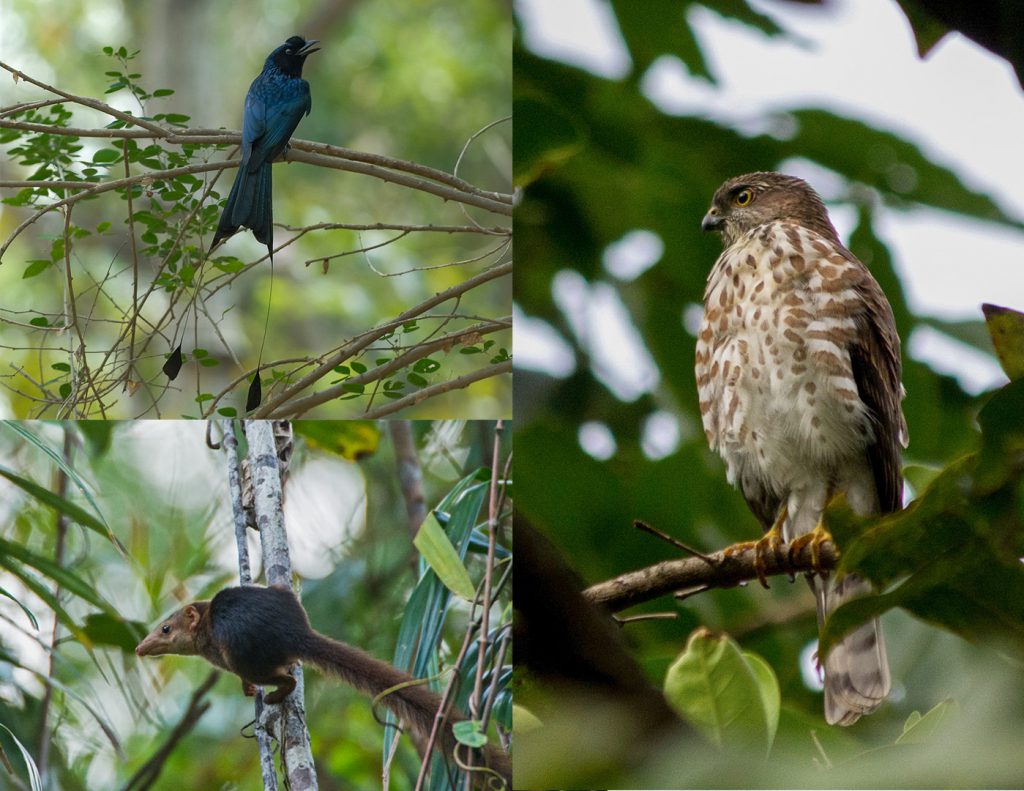
Transient or lifetime bonds
A common theme that researchers have noted is that mixed-species groups often seem to emerge in times of scarcity. During seasons of abundance, animals may not form such groups.
“In places like India and Africa, mixed-species flocks of birds are observed during the dry seasons,” points out Umesh Srinivasan, Associate Professor at CES, who studies mixed-species groups in the Eastern Himalayas.
This points to a key distinction – individuals in mixed-species groups can join or leave these associations depending on resource availability, unlike single-species groups, where members often remain committed, especially when young ones needing parental care are involved.
This is in stark contrast to the pattern seen in the Amazon forests, where mixed species groups of birds stick together year-round – not because resources are scarce, but because the environment, though resource-rich, is also highly competitive and teeming with predators.
Research has shown that the strategies behind group formation are far more complex and highly context dependent. Remarkably, there have also been observations of groups formed between a bird and its potential prey. During fieldwork in the Great Nicobar Islands in 2000, Kartik and fellow researcher Meera Oommen, who together co-founded the Dakshin Foundation, witnessed interactions between tree shrews (small insect-eating mammals), sparrowhawks (small predatory birds), and racket-tailed drongos.
Meera’s study showed that tree shrews would flush out insects and other small vertebrates while foraging through the undergrowth, providing prey for the drongo and sparrowhawk. However, it was noted that tree shrews preferred to keep a greater distance from sparrowhawks and were more likely to form such associations when a drongo was present, possibly to reduce predation risk from the sparrowhawks.
Though the study had to be discontinued after the 2004 tsunami hit the islands, it exemplified how species can change their typical behaviours to form such associations.
Field challenges
Studying mixed-species groups is uniquely challenging, as it involves tracking not one but various species across difficult terrains. In reefs, for example, researchers had to learn scuba diving, follow fish groups underwater with a camera and then spend weeks analysing the data in the lab to identify the species and their interactions.
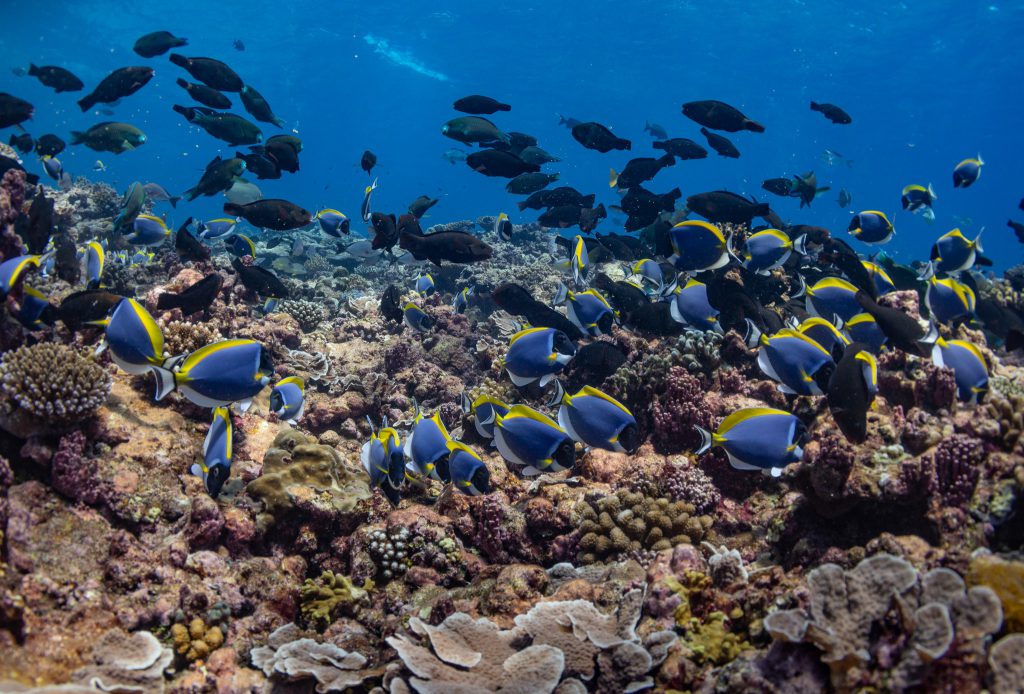
The same challenges arise in terrestrial landscapes too – especially when tracking birds. Priti had to learn various bird calls to identify them; in dense forests, where sightings are rare, bird calls may be the only clue. In the early days in the field, this could be confusing, although, she admits, she did find a new thrill in learning unfamiliar calls. “I used to get excited while watching a mixed-species group. I would eagerly listen and wonder, ‘Is that a racket-tailed drongo mimicking something? Or did I just hear a paradise flycatcher?’” Priti recalls.
For Santanu, it was a completely different struggle in the dry scrub and deciduous forest of the Anamalai Hills: “For nearly six months, it has been extremely dry at my field site, and every day began with the weight of 4-5 litres of water and food for the whole day strapped to my back during the field season, from dawn to dusk. In that desolate dryness, every observation was both a fear and a privilege.”
Additionally, as most of this research is in pristine, protected areas, it requires extensive forest permits and skilled field assistants familiar with the landscape and logistics.
Besides field challenges, fleeting animal sightings restrict the scope of the research. Researchers often get only brief glimpses of groups, limiting detailed behavioural observations. “Getting measurements of anything beyond species composition is nearly impossible in the field, especially for tropical bird flocks,” points out Kartik.
Umesh’s lab is trying to partially solve this challenge by tagging individual birds. This has allowed them to show that an individual from one species was consistently pairing with the same individual of another species.
Advanced technologies like drones and stereo cameras can help explore other aspects of mixed-species group interactions – for instance, the role of bird calls in communication and group formation, a current research focus in Kartik Shanker’s lab. His lab is also expanding research into other ecosystems, such as wetland bird communities.
Shifting climate, shifting alliances
Despite the challenges, researchers are still uncovering new nuances and subtleties behind diverse mixed-species interactions. Unfortunately, these important ecological interactions are being increasingly disrupted by climate change and human activity.
A study from Umesh’s lab found that logging – the selective harvesting of trees – impacts mixed-species associations. It showed that logging led to fewer species interacting in the understorey, likely because the loss of dense vegetation reduced the availability of food and microhabitats, leaving fewer opportunities for such associations to form.
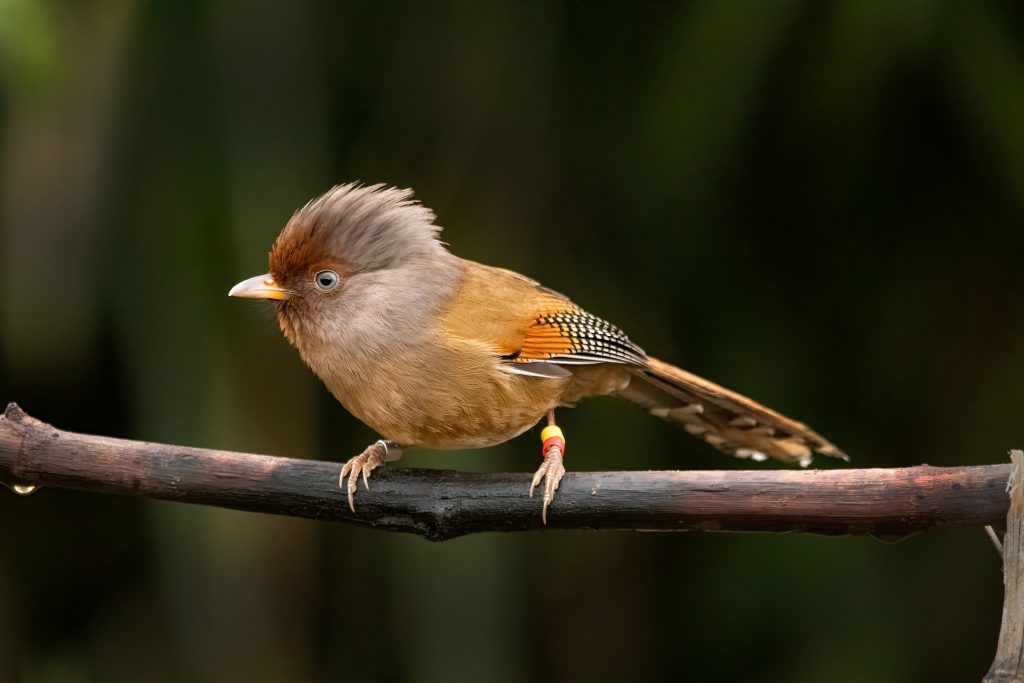
Eaglenest Wildlife Sanctuary, Arunachal Pradesh, to track its interactions
with other species (Photo courtesy: Aman Biswakarma)
In contrast, both the number and strength of species associations in the midstorey actually increased with heavier logging. As thinning of the forest canopy makes birds more visible to predators, they tend to flock together more often, likely as a strategy for shared vigilance and safety.
Umesh’s lab also found that global warming is pushing birds uphill, alongside the effects of logging in the forests of the Eastern Himalayas. Umesh hypothesises that this may cause many mixed-species groups to break apart and reassemble. Such shifts could be harmful for species that rely heavily on the stability of their groups for survival, although more data is needed to confirm this.
Reef fishes, too, are being impacted by climate change. Corals – home to symbiotic algae – are degrading due to rising global temperatures. As these algae die off, the availability of food for coral reef fishes like surgeonfish and parrotfish declines, reducing the frequency of their group formations. However, new associations are emerging. For instance, goatfish (Parupeneus indicus), which feed by disturbing the sand to uncover small animals, are now often followed by wrasse fishes that take advantage of the stirred-up prey.
Clearly, animals form mixed-species groups as a smart strategy to cope with the growing challenges of climate change and human-induced habitat degradation. Just as importantly, these interactions serve as indicators of ecosystem health. Studying them is therefore crucial – not only to understand their benefits, but also to assess how disruptions might harm the species involved.
The public, too, can play a role in studying these fascinating ecological relationships. “We are trying to introduce some citizen science initiatives through which recreational divers can collect information about reef fish, including potentially MSGs,” says Kartik. “While such data may be fairly coarse, these practices can raise awareness about mixed-species groups and their importance.”
Mohit Nikalje completed his MSc in Life Sciences at IISc and was a science writing intern at the Office of Communications. He is currently working as a science communicator at the Atal Incubation Centre (AIC) – CCMB, Hyderabad.
(Edited by Abinaya Kalyanasundaram)

